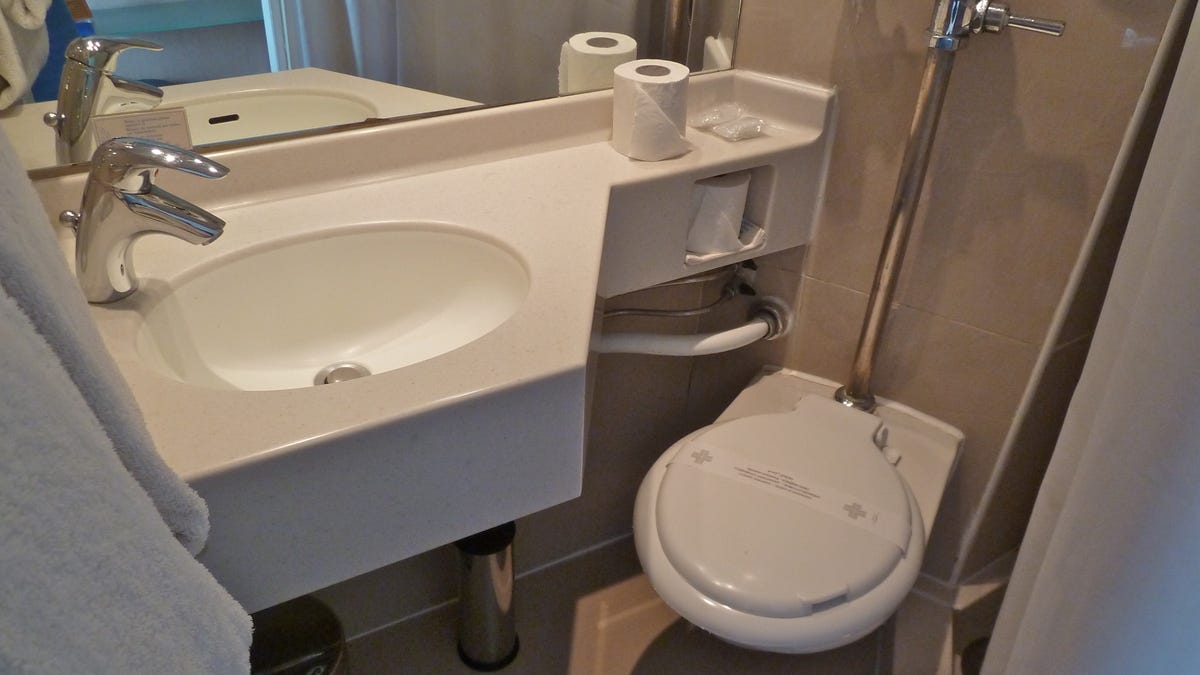
Public toilet flushes can send more poop than you might expect
Engineers from the University of Colorado Boulder used laser lights to see what happens when you flush a public toilet.
As with the great debate over which way the toilet paper roll goes, flushing has a similar clue: Is the lid open or closed?
Scientists have weighed in with their own sad conclusion: There is no solution to stop the spread of dangerous germs.
Microbiologist Charles Gerba and his research team at the University of Arizona determined that it made little difference whether you left the lid up or down. Closing the lid of a residential toilet does not prevent the spread of virus particles from the powerful whoosh of a flushed toilet.
In a study published Thursday in the American Journal of Infection Control, researchers concluded that when a person cleans a toilet, regardless of whether the lid is up or down, microscopic virus particles are spread on the floor and nearby toilet surfaces. The only meaningful way to reduce the spread of viral pathogens such as norovirus is to disinfect toilets, toilet water and nearby surfaces.
“A lot of people said that all you have to do is close the lid and the problem is solved,” says Gerba, who has been studying toilet germs for nearly half a century. “When you flush, all that air goes somewhere, and it blows the viruses out of the toilet bowl.”
Previous studies have concluded that closed lids reduce bacterial contamination of nearby surfaces, and researchers have sought to raise awareness of how uncovered toilets can release germ-laden plumes into public toilets. But Gerba's team examined whether the same was true for tiny virus particles in residential toilets and found little difference.
Past studies have linked aerosolized plumes from toilet flushes to norovirus outbreaks on cruise ships and airplanes, and in schools. On one cruise ship with the worst outbreak, testing revealed norovirus particles in half of the toilets, Gerba said.
“You should always make sure to clean the toilet seat and other areas in the restroom,” Gerba said.
How did the study go?
Gerba's team examined public toilets in an office building and toilets in a residential home. The public toilet was without a tank, inside a stall and flushed with a pressurized water line. The household toilet consisted of a tank in a small toilet.
The team included researchers from Reckitt Benckiser, a UK-based group that sells consumer products including Lysol.
Study organizers added virus particles to toilets and measured contamination on the toilet and nearby toilet surfaces one minute later.
Because public toilets typically do not have lids, the researchers measured data on lid closure only from household toilets. The study found no difference in overall virus contamination if the residential toilet lid was left open or closed before flushing, but it noted that the closed lid may have altered the “trajectory of aerosol plume contamination.”
When the lid was closed before flushing, the researchers measured slightly more contamination to the left and front of the toilet, but slightly less contamination to the right of the toilet.
Toilet bowls cleaned with a brush and disinfectant, hydrochloric acid, had less contamination than those cleaned with a brush. Cleaning the bowl with disinfectant reduces contamination of adjacent surfaces such as the toilet floor and toilet brush tray, the study suggests.
According to the study, “Closing the toilet lid before flushing does not reduce the risk of contamination of bathroom surfaces and disinfection of all toilet surfaces after flushing or toilet brush use is essential.” Germs.
In other words, you have to clean the toilet every time with germ-killing chemicals and a brush. Then wash your hands.
Hospital patients suffer from toilet germs
Other researchers have found little doubt after particles are forced out of a toilet bowl.
Matthew Nonenman, a professor at the University of Nebraska Medical Center College of Public Health, sees value in keeping the lid on when one is available.
“This is a personal question: Have you ever sat on the toilet and cleaned it?” Nonman said. “You feel the impact of the particles on your skin.”
Nonenman's team analyzed particles and bioaerosols from cleaning hospital toilets during routine patient care. His study After 30 minutes of washing, such impurities remain in a toilet.
Healthy people with strong immune systems can fight off such pathogens. But immunocompromised patients in the hospital can develop bacterial infections such as Clostridium difficile, also known as C. difficile.
Covering the lid — along with regular use of disinfectants and hand washing — can help keep things hygienic.
“If you close the lid, you reduce some of the larger particles that fly out of the toilet,” Nonenman said.
What steps should I take to reduce germs in the bathroom?
Although the UA-Reckitt Benckiser study doesn't recommend how often toilets should be cleaned, Gerba said homeowners should clean toilets and nearby surfaces regularly.
He recommends keeping a disinfectant near the toilet and disinfecting wipes to clean the toilet handle after use. People should always wash their hands thoroughly and use hand sanitizer, especially if someone in the household is infected with the virus, Gerba said.
If a household member has diarrhea — indicating possible exposure to norovirus or salmonella — Gerba recommends disinfecting toilet seats, flushers and other high-touch bathroom surfaces twice a day.
Of course, users have less control over how often a public toilet is cleaned, but people can still protect themselves by washing hands and using hand sanitizer.
In addition to regularly washing your hands and cleaning the bathroom with disinfectant, Nonenman recommends tossing your toothbrush and any cosmetics you put on your face. People should also avoid handling their phones while using the restroom.
Phones in the bathroom? There is a discussion for a new generation.
Ken Alltucker at X, formerly on Twitter, @kalltucker, or can be emailed at [email protected].

